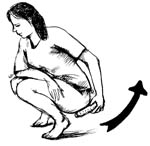18.3 Urinary tract infections
The urinary tract (see Figure 18.5) includes the kidneys, kidney tubes, bladder and urethra (the opening where urine comes out of the body). They are all connected and work together to get rid of body wastes from the blood. First the kidneys clean the blood and turn waste into urine. Then the urine goes down the kidney tubes to the bladder. The urine stays in the bladder until the person urinates (passes water).
Urinary tract infection occurs when harmful germs (bacteria) get into the urethra. The infection can easily spread upwards to the bladder or kidneys. Doctors often refer to urinary tract infections as UTIs (when you say this it sounds like ‘you-tee-eyes’). You should assume that a UTI may involve all levels of the tract: the urethra, the bladder and the kidneys.
A woman is more likely to get UTIs during pregnancy than at other times. UTIs – particularly those that get all the way up to the kidneys – can be very dangerous for the mother and can also cause her to start labour too early if they are not treated right away. This is why it is important to check for signs of infection at every antenatal visit.

18.2.3 Treatment of anaemia in pregnancy
